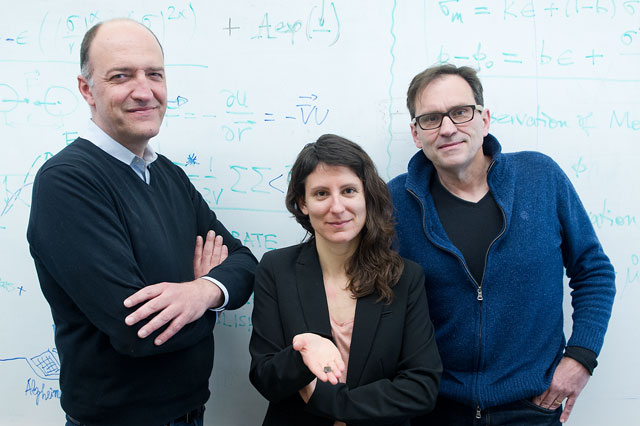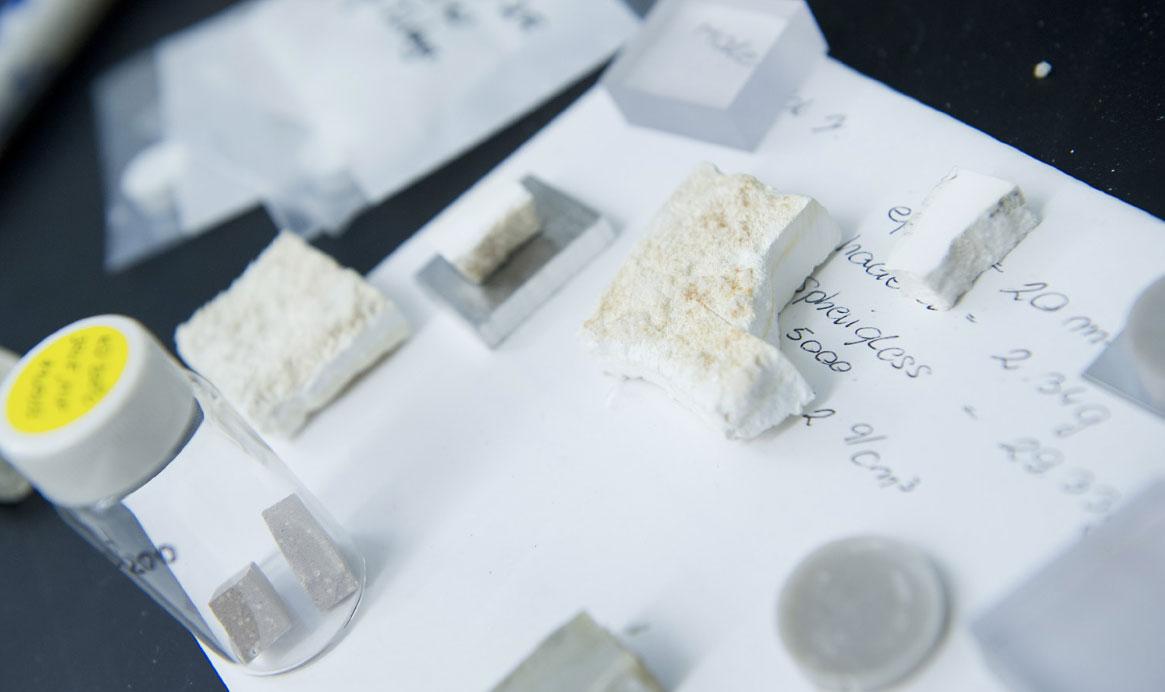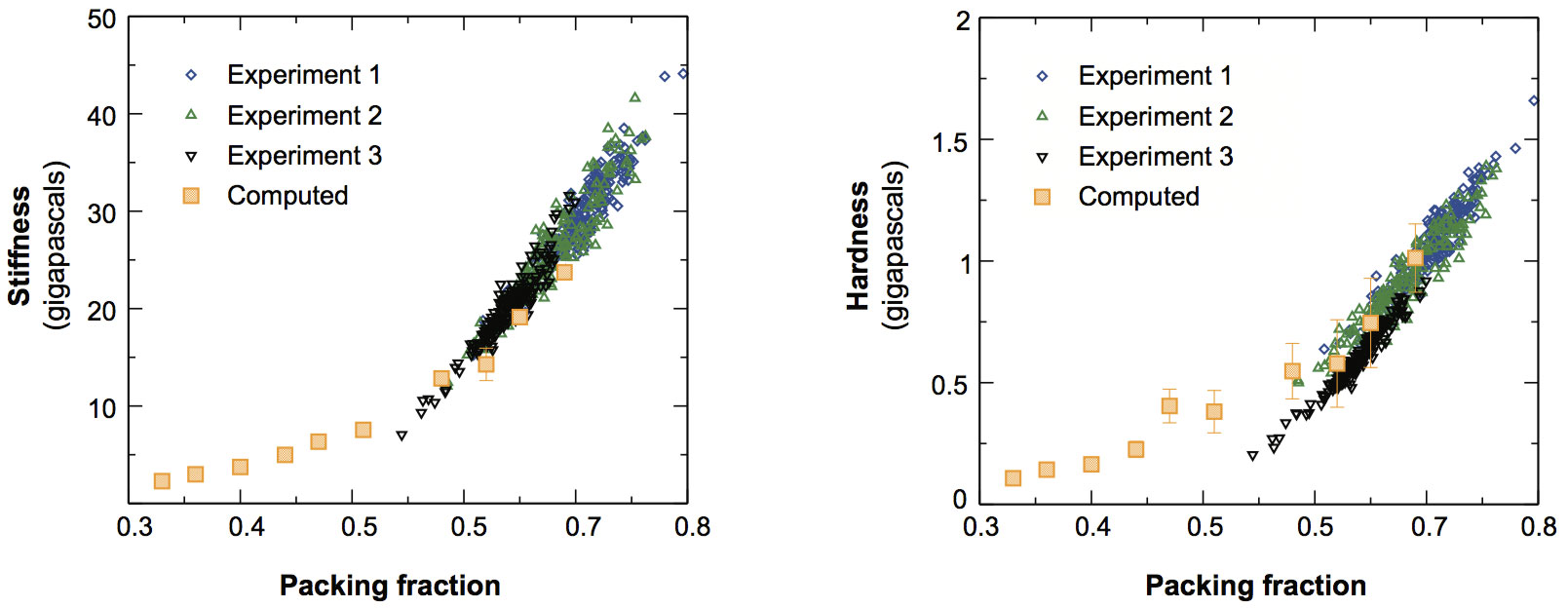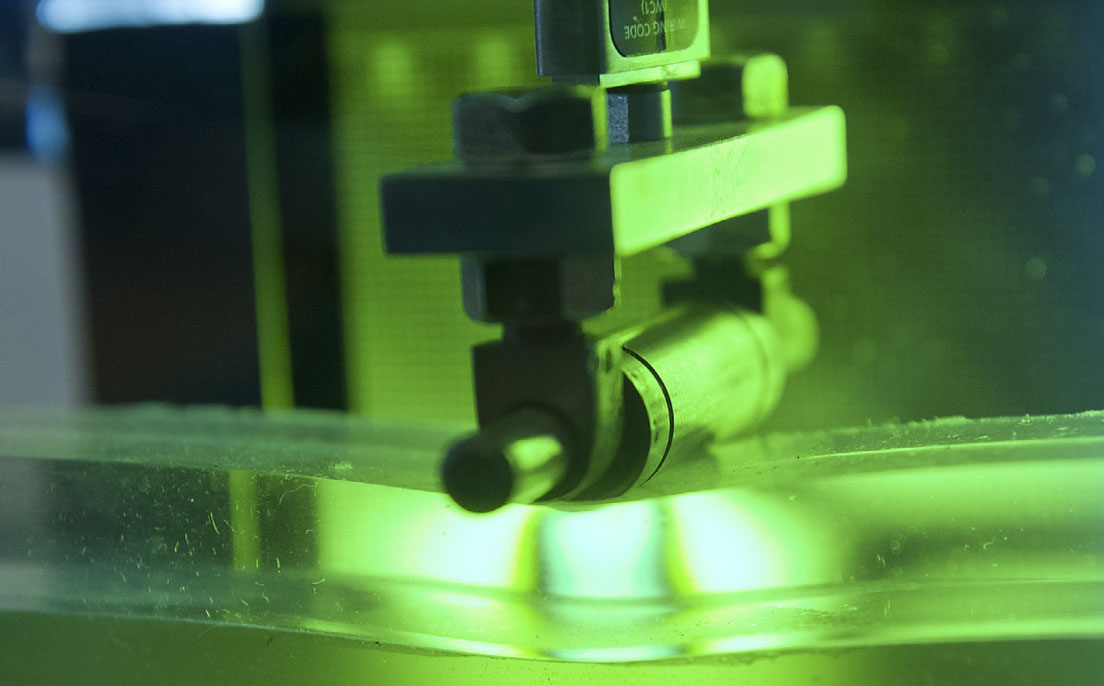
Overview
An MIT-led team has defined the nanoscale forces that control how particles pack together during the formation of cement “paste,” the material that holds together concrete and causes that ubiquitous construction material to be a major source of greenhouse gas emissions. By controlling those forces, the researchers will now be able to modify the microstructure of the hardened cement paste, reducing pores and other sources of weakness to make concrete stronger, stiffer, more fracture-resistant, and longer-lasting. Results from the researchers’ simulations explain experimental measurements that have confused observers for decades, and they may guide the way to other improvements, such as adding polymers to fill the pores and recycling waste concrete into a binder material, reducing the need to make new cement.
Each year, the world produces 2.3 cubic yards of concrete for every person on earth, in the process generating more than 10% of all industrial carbon dioxide (CO2) emissions. New construction and repairs to existing infrastructure currently require vast amounts of concrete, and consumption is expected to escalate dramatically in the future. “To shelter all the people moving into cities in the next 30 years, we’ll have to build the equivalent of several hundred New York cities,” says Roland Pellenq, senior research scientist in civil and environmental engineering (CEE) and research director at France’s National Center for Scientific Research (CNRS). “There’s no material up to that task but concrete.”
Recognizing the critical need for concrete, Pellenq and his colleague Franz-Josef Ulm, professor of CEE and director of the MIT Concrete Sustainability Hub (CSHub), have been working to reduce its environmental footprint. Their goal: to find ways to do more with less. “If we can make concrete stronger, we’ll need to use less of it in our structures,” says Ulm. “And if we can make it more durable, it’ll last longer before it needs to be replaced.”
Surprisingly, while concrete has been a critical building material for 2,000 years, improvements have largely come from trial and error rather than rigorous research. As a result, the factors controlling how it forms and performs have remained poorly understood. “People always deemed what they saw under a microscope as being coincidence or evidence of the special nature of concrete,” says Ulm, who with Pellenq co-directs the joint MIT-CNRS laboratory called MultiScale Material Science for Energy and Environment, hosted at MIT by the MIT Energy Initiative (MITEI). “They didn’t go to the very small scale to see what holds it together—and without that knowledge, you can’t modify it.”
To shelter all the people moving into cities in the next 30 years, we’ll have to build the equivalent of several hundred New York cities. There’s no material up to that task but concrete.
Roland Pellenq

Cement: the key to better concrete
The problems with concrete—both environmental and structural—are linked to the substance that serves as its glue, namely, cement. Concrete is made by mixing together gravel, sand, water, and cement. The last two ingredients combine to make cement hydrate, the binder in the hardened concrete. But making the dry cement powder requires cooking limestone (typically with clay) at temperatures of 1,500°C for long enough to drive off the carbon in it. Between the high temperatures and the limestone decarbonization, the process of making cement powder for concrete is by itself responsible for almost 6% of all CO2 emissions from industry worldwide. Structural problems can also be traced to the cement: When finished concrete cracks and crumbles, the failure inevitably begins within the cement hydrate that’s supposed to hold it together—and replacing that crumbling concrete will require making new cement and putting more CO2 into the atmosphere.
To improve concrete, then, the researchers had to address the cement hydrate—and they had to start with the basics: defining its fundamental structure through atomic-level analysis. In 2009, Pellenq, Ulm, and an international group of researchers associated with CSHub published the first description of cement hydrate’s 3-dimensional molecular structure. Subsequently, they determined a new formula that yields cement hydrate particles in which the atoms occur in a specific configuration—a “sweet spot”—that increases particle strength by 50%.
However, that nanoscale understanding doesn’t translate directly into macroscale characteristics. The strength and other key properties of cement hydrate actually depend on its structure at the “mesoscale”—specifically, on how nanoparticles have packed together over hundred-nanometer distances as the binder material forms.
When dry cement powder dissolves in water, room-temperature chemical reactions occur, and nanoparticles of cement hydrate precipitate out. If the particles don’t pack tightly, the hardened cement will contain voids that are tens of nanometers in diameter—big enough to allow aggressive materials such as road salt to seep in. In addition, the individual cement hydrate particles continue to move around over time—at a tiny scale—and that movement can cause aging, cracking, and other types of degradation and failure.
To understand the packing process, the researchers needed to define the precise physics that drives the formation of the cement hydrate microstructure—and that meant they had to understand the physical forces at work among the particles. Every particle in the system exerts forces on every other particle, and depending on how close together they are, the forces either pull them together or push them apart. The particles seek an organization that minimizes energy over length scales of many particles. But reaching that equilibrium state takes a long time. When the Romans made concrete 2,000 years ago, they used a binder that took many months to harden, so the particles in it had time to redistribute so as to relax the forces between them. But construction time is money, so today’s binder has been optimized to harden in a few hours. As a result, the concrete is solid long before the cement hydrate particles have relaxed, and when they do, the concrete sometimes shrinks and cracks. So while the Roman Colosseum and Pantheon are still standing, concrete that’s made today can fail in just a few years.
Structure of hardened cement hydrate

The research challenge
Laboratory investigation of a process that can take place over decades isn’t practical, so the researchers turned to computer simulations. “Thanks to statistical physics and computational methods, we’re able to simulate this system moving toward the equilibrium state in a couple of hours,” says Ulm.
Based on their understanding of interactions among atoms within a particle, the researchers—led by MITEI postdoc Katerina Ioannidou—defined the forces that control how particles space out relative to one another as cement hydrate forms. The result is an algorithm that mimics the precipitation process, particle by particle. By constantly tracking the forces among the particles already present, the algorithm calculates the most likely position for each new one—a position that will move the system toward equilibrium. It thus adds more and more particles of varying sizes until the space is filled and the precipitation process stops.
Results from sample analyses appear in the first two diagrams in the figure above. The width of each simulation box is just under 600 nanometers—about a tenth the diameter of a human hair. The two analyses assume different packing fractions, that is, the total fraction of the simulation box occupied by particles. The packing fraction is 0.35 in the left-hand diagram and 0.52 in the center diagram. At the lower fraction, far more of the volume is made up of open pores, indicated by the white regions.
The third diagram in the figure above is a sketch of the cement hydrate structure proposed in pioneering work by T.C. Powers in 1958. The similarity to the center figure is striking. The MIT results thus support Powers’ idea that the formation of mesoscale pores can be attributed to the use of excessive water during hydration—that is, more water than needed to dissolve and precipitate the cement hydrate. “Those pores are the fingerprint of the water you put into the mix in the first place,” says Pellenq. “Add too much water, and at the end you’ll have a cement paste that is too porous, and it will degrade faster over time.”
Measured and calculated cement hydrate stiffness and hardness

To validate their model, the researchers performed experimental tests and parallel theoretical analyses to determine the stiffness and hardness (or strength) of cement hydrate samples. The laboratory measurements were taken using a technique called nanoindentation, which involves pushing a hard tip into a sample to determine the relationship between the applied load and the volume of deformed material beneath the indenter.
The figures above show results from small-scale nanoindentation tests on three laboratory samples (small symbols) and from computations of those properties in a “sample” generated by the simulation (yellow squares). The figure on the left shows results for stiffness, the figure on the right results for hardness. In both cases, the X-axis indicates the packing fraction. The results from the simulations match the experimental results well. (The researchers note that at lower packing fractions, the material is too soggy to test experimentally—but the simulation can do the calculation anyway.)
All of a sudden we could explain this signature, this mystery, but on a physics basis in a bottom-up fashion. That was a really big step.
Franz-Josef Ulm
In another test, the team investigated experimental measurements of cement hydrate that have mystified researchers for decades. A standard way to determine the structure of a material is using small-angle neutron scattering (SANS). Send a beam of neutrons into a sample, and how they bounce back conveys information about the distribution of particles and pores and other features on length scales of a few hundred nanometers.
SANS had been used on hardened cement paste for several decades, but the measurements always exhibited a regular pattern that experts in the field couldn’t explain. Some talked about fractal structures, while others proposed that concrete is simply unique.
To investigate, the researchers compared SANS analyses of laboratory samples with corresponding scattering data calculated using their model. The experimental and theoretical results showed excellent agreement, once again validating their technique. In addition, the simulation elucidated the source of the past confusion: The unexplained patterns are caused by the rough edges at the boundary between the pores and the solid regions. “All of a sudden we could explain this signature, this mystery, but on a physics basis in a bottom-up fashion,” says Ulm. “That was a really big step.”

New capabilities, new studies
“We now know that the microtexture of cement paste isn’t a given but is a consequence of an interplay of physical forces,” says Ulm. “And since we know those forces, we can modify them to control the microtexture and produce concrete with the characteristics we want.” The approach opens up a new field involving the design of cement-based materials from the bottom up to create a suite of products tailored to specific applications.
The CSHub researchers are now exploring ways to apply their new techniques to all steps in the life cycle of concrete. For example, a promising beginning-of-life approach may be to add another ingredient—perhaps a polymer—to alter the particle-particle interactions and serve as filler for the pore spaces that now form in cement hydrate. The result would be a stronger, more durable concrete for construction and also a high-density, low-porosity cement that would perform well in a variety of applications. For instance, at today’s oil and natural gas wells, cement sheaths are generally placed around drilling pipes to keep gas from escaping. “A molecule of methane is 500 times smaller than the pores in today’s cement, so filling those voids would help seal the gas in,” says Pellenq.
The ability to control the material’s microtexture could have other, less-expected impacts. For example, novel CSHub work has demonstrated that the fuel efficiency of vehicles is significantly affected by the interaction between tires and pavement. Simulations and experiments in the lab-scale setup shown in the image above suggest that making concrete surfaces stiffer could reduce vehicle fuel consumption by as much as 3% nationwide, saving energy and reducing emissions.
Perhaps most striking is a concept for recycling spent concrete. Today, methods of recycling concrete generally involve cutting it up and using it in place of gravel in new concrete. But that approach doesn’t reduce the need to manufacture more cement. The researchers’ idea is to reproduce the cohesive forces they’ve identified in cement hydrate. “If the microtexture is just a consequence of the physical forces between nanometer-sized particles, then we should be able to grind old concrete into fine particles and compress them so that the same force field develops,” says Ulm. “We can make new binder without needing any new cement—a true recycling concept for concrete!”
This research was supported by Schlumberger; France’s National Center for Scientific Research (through its Laboratory of Excellence Interdisciplinary Center on MultiScale Materials for Energy and Environment); and the Concrete Sustainability Hub at MIT. Schlumberger is a Sustaining Member of the MIT Energy Initiative. The research team also included other investigators at MIT; the University of California at Los Angeles; Newcastle University in the United Kingdom; and Sorbonne University, Aix-Marseille University, and the National Center for Scientific Research in France. Further information can be found in:
K. Ioannidou, K.J. Krakowiak, M. Bauchy, C.G. Hoover, E. Masoero, S. Yip, F-J. Ulm, P. Levitz, R.J-M. Pellenq, and E. Del Gado. “Mesoscale texture of cement hydrates.” Proceedings of the National Academy of Sciences, vol. 113, no. 8, pp. 2029–2034, 2016.
R.J-M. Pellenq, A. Kushima, R. Shahsavari, K.J. Van Vliet, M.J. Buehler, S. Yip, and F-J. Ulm. “A realistic molecular model of cement hydrates.” Proceedings of the National Academy of Sciences, vol. 106, no. 38, pp. 16102–16107, 2009.
M.J.A. Qomi, K.J. Krakowiak, M. Bauchy, K.L. Stewart, R. Shahsavari, D. Jagannathan, D.B. Brommer, A. Baronnet, M.J. Buehler, S.Yip, F.-J. Ulm, K.J. Van Vliet, and R.J-M. Pellenq. “Combinatorial molecular optimization of cement hydrates.” Nature Communications, vol. 5, doi:10.1038/ncomms5960, 2014.
This article appears in the Spring 2016 issue of Energy Futures.